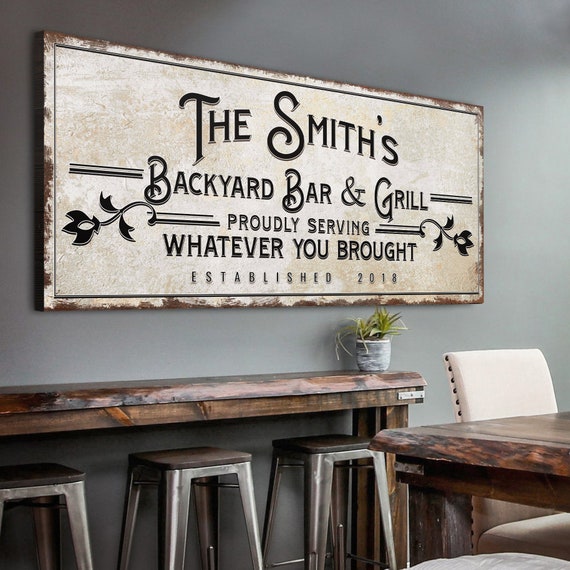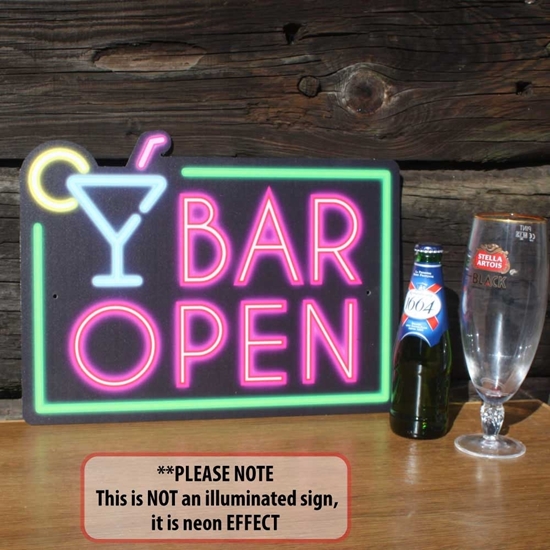Free Tips On Deciding On Gin Bar Signs
Wiki Article
How Can Bar Signs Differ In Size?
The size of bar signs varies according to their function as well as their location and design aesthetic. This article provides a detailed breakdown of how the size of bar signs affects their effectiveness and awe. The Large Sign
Use for: to bring attention to an location and act as a focal area.
Uses: Signage used for the exterior, main branding signs, or walls with features.
Location: Usually, it is placed over entrances, on huge walls, or even outside the bar to attract patrons.
Examples: huge neon signs large vintage-style signs, or massive wall-mounted signs.
2. Medium Signs
Use: To display information or to enhance the appearance of a space, without overpowering it.
Applications: menu boards, displays for promotions, and signs for directional purposes.
Placement: Positioned in a way that's clear but not overwhelming. For instance behind the bar, above seating areas, or on walls that are feature.
Examples: Medium-sized chalkboards that advertise daily specials, signs made of metal with the logo of the bar, or themed decorative signs.
3. Small Signs
The purpose is to provide precise details or subtle ornamental elements.
Uses : Table signs, decorative items, labels, etc.
Tables, shelves or in displays to get close-up views.
Small quotes or drinks menus to illustrate.
Size Considerations
Visibility
Signs that are big They can be visible from afar and will attract passersby. They also indicate the presence of an establishment.
Medium Signs They are perfect for balancing visibility with space effectiveness, and also providing vital information without overwhelming decor.
Small Signs are best for providing information with close proximity and in-depth specifics. This can enhance the experience of customers.
Proportion
Large Signs: They should be proportional to the size of the space to avoid overwhelming smaller areas. Perfect for large or open areas.
Medium Signs: Ideal for most indoor spaces and allows for a variety of placement.
Small signs are ideal for adding detail to cramped spaces and making them fit into smaller spaces without creating clutter.
Impact
Signs of a large size make a strong and strong statement. This is an important aspect of branding. It is commonly employed to set the atmosphere for a bar.
Medium Signs are a good mix of the design and the glare. They help create a pleasant atmosphere, and also communicate important information.
Small signs: They bring elegance and detail to your visual experience enhancing it.
Practicality
Large Signs: require large mounting solutions and may be more costly because of the size and material.
Medium signs offer more flexibility when it comes to design and are easier to install.
Small Signs are extremely flexible and easy to change, ideal for settings that are dynamic, such as bars with a constant change in menus or promotions.
Functionality
Large Signs: Mostly used to increase visibility and attract attention.
Medium Signs are a great source of information as well as aesthetic appeal.
Small Signs: Created to provide detailed information and support the overall theme in a subtle manner.
The ideal size of bar signage is determined by their intended use, the design, and the impact they have on the patrons. Signs will help to improve the ambience and efficiency of the bar if they are balanced. Follow the best personalised pub signs for blog examples including the staying inn pub sign, personalised metal bar signs, pub signs personalised, pub bar signs for sale, personalised signs for home bar, bar pub signs, personalised cocktail bar sign, a bar sign, bar signs, home bar pub signs and more.

What Is The Difference Between Bar Signs And Other Types Of Signage In Terms Of Light?
The bar signs differ greatly in lighting which can affect their ambiance, visibility, as well as their overall impression. Here are the main methods by which variations in lighting affect bar signs: 1. Neon Signs
Characteristics: Bright, colorful, classic.
Lighting: Make use of gas tubes filled with neon that emit illumination when they are electrically charged.
Uses: Great to create a retro vintage style. Often used for branding and bar names.
Advantages: Highly visible, even from a distance and has a nostalgic appeal.
It's fragile, and repairs are costly.
2. LED Signs
Characteristics: Energy-efficient, versatile, modern.
Lighting: Make use of LEDs to produce bright and vibrant lighting.
Uses: Great for indoor and outdoor signage, programmable displays and dynamic lighting effects.
Advantages: Long-lasting, energy-efficient and programmable to play animations or change color.
Some disadvantages include the initial cost however, it is cheaper to pay for energy and maintenance expenses.
3. Backlit Signs
Characteristics: Elegant, sophisticated, subtle.
Lighting: Utilizes light sources such as fluorescent bulbs or LEDs, behind a translucent surface to create an ethereal glow.
Uses: Used for modern bar signs, menu boards, branding elements, etc.
Advantages: Clean and professional appearance, which improves readability in low lighting.
Disadvantages: More complex installation and higher upfront cost.
4. Edge-Lit Signs
Characteristics: Sleek, contemporary, stylish.
Lighting: Illuminates the edges of a sign usually acrylic, using LEDs.
Uses : Suitable for modern minimalist designs.
Advantages Provides a classy and distinct look.
Disadvantages: Limited to specific design styles.
5. Ambient/Accent Lighting
Characteristics: Subtle, atmospheric, decorative.
Lighting: Indirect lighting is used to highlight or accentuate signs.
Uses: Improves the atmosphere It is often used to highlight art or themed décor.
Benefits: Creates an atmosphere and depth to create a warm and welcoming space.
Disadvantages : Direct illumination may not be enough for reading.
6. Marquees, Signs
Characteristics: Bold, theatrical, eye-catching.
Lighting: Brighten the sign with multiple bulbs or LEDs.
Uses : Popular for creating old-fashioned film designs and exterior signage.
Benefits: Excellent visibility and attention-grabbing.
Advantages: May be expensive and requires regular maintenance.
7. Projection signs
Characteristics: Dynamic, innovative, versatile.
Lighting: Make use of projectors to project images and light onto a surface.
Uses : Perfect for temporary promotions, special events, and for dynamic displays.
Benefits: Simple to modify and no physical structure is needed.
Disadvantages
8. Fluorescent Signs
Characteristics: Bright, cost-effective, traditional.
Lighting: Fluorescent tubes are used to provide light.
Applications: Typically employed on large indoor and exterior signs.
The bright and vibrant colors are great for large-scale signs, but they're also relatively affordable.
Cons: They're less efficient in energy than LEDs and can produce a harsher lighting.
Tips for Lighting
Visibility
Neon and LED signposts: great for attracting your attention at a distance.
Signs that are backlit and edge-lit These are great to increase the visibility of your sign and giving it a refined appearance.
Energy Efficiency
LED signs: Energy efficient and durable.
The fluorescent and neon signs aren't as energy efficient as well as more fragile.
Aesthetic Appeal
Neon and marquee signs are ideal for vintage and retro aesthetics.
The perfect choice for modern and clean designs are signs that have an edge lit with backlighting.
Ambient Lighting: Helps create an ambiance that is more relaxing and inviting. environment.
Maintenance
LED Signs: Low-maintenance and durable.
neon signs as well as fluorescent signs: They need more frequent maintenance and possible repairs.
Cost
LED Backlit Signs - Higher initial costs, but less ongoing expenses
Fluorescent signs: lower initial costs, but higher costs for energy in the long run.
Flexibility
Projection LED Signs as well as Programmable LED Signs Provide flexibility and high-dynamic content for displays.
Traditional Signs: More rigid but usually provide a desired look.
Choose the right type lighting for your bar signs to enhance visibility, create an inviting ambience, and effectively convey your brand's message and promotional messages. See the most popular bar signs url for blog advice including pub sign hanging, personalised home bar signs, large bar signs, personalised signs for bar, the pub sign, bar pub signs, personalised signs for home bar, hanging tavern sign, personalised hanging pub signs, personalised pub signs for sale and more.

What Are The Differences Between Bar Signs And Regulations?
The sign for bars is subject to different rules and regulations, enforced by local or federal authorities to ensure the health of the public, aesthetic standards as well as compliance with the zoning laws, and to ensure the welfare of the public. What are the rules that apply to bar signs? Size and Regulations on Positioning
Zoning laws: These regulations regulate where signs are placed and their size, distance, and height and the distance between them and property lines, roadways, or other buildings.
Historical Districts: Limitations may be in place to protect the historic nature of certain regions that limit the size, design and the materials used in signs.
2. Illumination Restrictions
Light Pollution: To minimize light pollution and protect the nighttime environment, regulations could limit the luminosity of the signs, their color and the time they last.
Safety Considerations Signs cannot produce glare and should not hinder drivers or pedestrians especially when they are located near the road.
3. Signage Content
Alcohol Advertising Certain states have strict rules on alcohol-related advertising that prohibit certain types of images or content that could attract minors or encourage excessive drinking.
Health Warnings: The law could mandate health warnings be displayed on signs about alcohol consumption and smoking.
4. Historic Preservation Regulations
Architectural Compatibility Signs have to match the style and design of the historic district. This often requires approval by preservation boards or commissions.
Materials and Design. Restrictions on sign materials and design, as well as color schemes may be applied to maintain historic integrity.
5. Sign Permitting Process
Permit Specifications. Prior to installing or altering signs, bar owners might require plans to be submitted to pay for fees, and then get permission from local authorities.
Code Compliance: To guarantee accessibility and security for the public the signs must comply with construction codes as well as safety regulations and accessibility standards.
6. Sign Removal Repair, Maintenance and Removal
Maintenance Requirements Bar owners are accountable to ensure that their signs are in good condition, ensuring they're sturdy, free of hazards, and compliant with regulations.
Signs that are abandoned or damaged To prevent pollution and preserve the beauty in the area, there might be laws that govern the destruction of signs which are abandoned or disused.
7. Digital Signage Regulations
Content Restrictions - Laws may restrict the content that is displayed on digital signage for instance by banning flashing lights or offensive imagery.
Limits to operation: Regulations could restrict the brightness, speed or frequency with the point that digital signs alter to reduce visual noise.
8. Penalties and Enforcement
Inspections: Local authorities inspect signs periodically to ensure they're in compliance the signage regulations. They issue citations when violations are found.
Penalties: Penalties for non-compliance can include fines, citations for removal or alter signs, as well as legal actions.
9. Sign Process
Variance Applications Bar owners can apply for a variance from the normal signage rules. This is done by proving that there is a good justification for the change and making sure that there is no negative effect on aesthetics or public safety.
Public Input: Some variations may require community input for instance, public hearings or feedback from property owners or businesses associations, or even comments from the community.
10. Community Input & Engagement
Public Consultation Some jurisdictions ask residents to assist with the creation of regulations. This can be done through public meetings, survey or stakeholder consultative processes.
Sign Regulations Can Have Community Benefits for Communities. Sign regulations can include provisions to improve the appearance of signs, promote local business, or help revitalize neighborhoods.
Knowing and adhering to the regulations for signage will allow bar owners to ensure their signs contribute positively to surrounding communities, comply with legal requirements and minimize the risk of fines and penalties. Read the most popular cocktail bar sign for site examples including hanging pub signs personalised, garden bar signs, hanging pub signs for garden, personalised sign for bar, bar sign hanging, personalised cocktail sign, signs for the bar, large personalised bar signs, large personalised bar signs, the staying inn bar sign and more.
